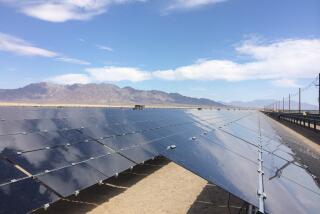Pasadena’s ESolar lands 2,000-megawatt deal in China
ESolar Inc. of Pasadena signed an agreement Friday to build a series of solar thermal power plants in China with a total capacity of 2,000 megawatts, in one of the largest renewable energy deals of its kind.
Coming four months after an Arizona company, First Solar, secured a contract to build an equally large photovoltaic power plant in China, the ESolar deal signals China’s emergence as a major market for renewable energy.
“They’re moving very fast, much faster than the state and U.S. governments are moving,” said Bill Gross, ESolar’s chairman and the founder of Idealab.
Under the agreement, ESolar will provide China Shandong Penglai Electric Power Equipment Manufacturing Co. the technology and expertise to build solar “power tower” plants over the next decade. Those solar farms would generate a total of 2,000 megawatts of electricity; at peak output that would be equivalent to a large nuclear power plant. The terms of the agreement were not disclosed.
The initial project, which includes a 92-megawatt solar power plant to be built this year, will be located in the 66-square-mile Yulin Energy Park in the Mongolian desert in northern China. The region has become a hot spot for renewable energy, with the 2,000-megawatt First Solar project planned 60 miles to the north.
Penglai Electric will manage the ESolar power plants’ construction and another firm, China Shaanxi Yulin Huayang New Energy Co., will own and operate the first projects.
Although China is the world leader in producing photovoltaic panels such as those found on residential rooftops, the ESolar deal is the country’s first big venture into large-scale solar thermal power production.
ESolar’s power plants use fields of mirrors called heliostats to focus the sun’s rays on a water-filled receiver that sits atop a slender tower. The intense heat vaporizes the water, and the resulting high-pressure steam drives an electricity-generating turbine.
“We chose ESolar because of its demonstration in commercial maturity, sustainability and long-term potential to compete against fossil fuel,” Eric Wang, a Penglai Electric spokesman, wrote in an e-mail from Beijing, where the deal was signed.
ESolar already manufactures its heliostat arrays in China, and under the terms of the agreement with Penglai it will also build its power plant receivers there. Gross said that ESolar would retain control of the intellectual property behind the technology’s design and operation.
Nathaniel Bullard, a solar energy analyst with consulting firm Bloomberg New Energy Finance, said the ESolar deal indicated China was moving aggressively to pinpoint technologies around the world that could help it meet its ambitious renewable energy goals.
“If you’re identified by China as a leading technology developer, the technology will be imported with the implication that your technology will over time become local,” he said. “You effectively have one stakeholder, the government, which makes development much easier.”
In August, ESolar, which is backed by Idealab, Google Inc. and other investors, threw the switch on its first project, the 5-megawatt Sierra SunTower demonstration power plant in Lancaster that supplies Southern California Edison.
“We have almost half a year of production and enough convincing data to convince a company that the technology works as advertised,” Gross said.
He said negotiations with Penglai Electric began about six months ago after executives approached ESolar and then flew to Los Angeles to see the Sierra plant.
Although the power tower concept is not new, ESolar relies on a sophisticated software system and imaging technology to control 176,000 small mirrors that form arrays at its standard 46-megawatt power plant. The software positions the mirrors to create a virtual parabola to focus the sun on the receiver tower.
The mirrors’ dimensions -- each is about the size of a television screen -- allow ESolar to make and install them cheaply and use less land for the power plant.
More to Read
Inside the business of entertainment
The Wide Shot brings you news, analysis and insights on everything from streaming wars to production — and what it all means for the future.
You may occasionally receive promotional content from the Los Angeles Times.









